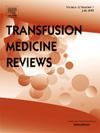Clash of the Standards: An Institutional Approach to Fulfilling ABO Confirmation Mandates While Upholding Patient Blood Management Principles
IF 2.5
2区 医学
Q2 HEMATOLOGY
引用次数: 0
Abstract
Introduction
IQMH standard VI.1 TM042 states there shall be a 2nd check of the ABO group (ABOConf) either by testing of a second sample or identifying supportive prior records, because verification is a pre-requisite for the provision of group-specific blood (GSB) for transfusion. The use of GSB in turn is valued in inventory management by decreasing the unnecessary use of group O red cells for non-O patients. However, Choosing Wisely advises against sampling more blood than is needed. As such, when lacking historical data, ABOConf demands additional venipuncture, though from the ensuing 7-10 ml specimen, only a few drops of blood are used. Our twin goal was to reduce ABOConf collections while decreasing turnaround times (TATs) by using existing samples. Avoiding new collections is patient-centred by eliminating repeat venipuncture discomfort and leveraging available alternative specimens, as iatrogenic blood loss is a known driver of anemia in healthcare. Furthermore, retroactive leveraging in a laboratory environment was recognized as uniquely free from the possibility of premeditated bedside "double-draw" fraud.
Design and Methods
When an order for red cell transfusion is received, the laboratory information system assists in determining if ABOConf is required. This flag recruits a technologist to determine if, among previously-collected CBCs, there is a sample meeting Transfusion Medicine (TM) labelling requirements (ie- an independent collection in the last 3 days). If present, the sample is retrieved and re-processed in an ABOConf order under the Confirmatory Blood Type Medical Directive. The original collection information (collector/date/time) is documented in the Clinical Information System (CIS). The ABOConf order process includes documentation of the specimen number used for testing, with verification that the sample was a collection distinct from the original Type and Screen. Only if an appropriate CBC is unavailable will a new blood draw occur.
Results
Six months (Jul-Dec 2024) were reviewed. Surgical order locations (Main Operating Room and Pre-operative Clinic) were assessed separately as a group exempt from the lab-ordered ABOConf process, owing to distinct expedient transfusion-readiness concerns. Of 567 non-surgical orders, 364 new collections (2,548 mL) were averted (64%), vs only 5 saved collections in 533 surgical samples (Z 22.2, p< .00001). A 10 day audit showed a TAT decrease as well in the use of previously-collected samples (average 12 minutes vs 77 for new collections).
Conclusions
The use of previously collected samples for ABOConf testing reduced sample collection significantly in the non-surgical population with significantly decreased TAT, while satisfying IQMH standards and Choosing Wisely recommendations. Future goals are to reduce specimen volume when ABOConf draws remain necessary, and to expand this process to Surgical locations.
标准的冲突:在坚持患者血液管理原则的同时实现ABO确认任务的制度方法
iqmh标准VI.1 TM042规定,应通过检测第二个样本或确定支持性先前记录对ABO血型(ABOConf)进行第二次检查,因为验证是提供用于输血的特定血型(GSB)的先决条件。GSB的使用反过来又通过减少非O型患者对O型红细胞的不必要使用而在库存管理中具有价值。然而,明智地选择建议不要取样过多的血液。因此,当缺乏历史数据时,ABOConf要求额外的静脉穿刺,尽管从随后的7-10毫升标本中,只使用几滴血。我们的两个目标是减少ABOConf收集,同时通过使用现有样本减少周转时间(tat)。避免新的采集以患者为中心,消除重复静脉穿刺的不适,并利用可用的替代标本,因为医源性失血是医疗保健中贫血的已知驱动因素。此外,实验室环境中的追溯杠杆被认为是唯一不存在有预谋的床边“双抽”欺诈的可能性。设计和方法当收到红细胞输血订单时,实验室信息系统协助确定是否需要ABOConf。该标志招募一名技术人员,以确定在以前收集的全血细胞中是否有符合输血医学(TM)标签要求的样本(即在过去3天内独立收集)。如果存在,则根据《确认血型医学指令》的ABOConf命令提取样本并重新处理。原始收集信息(收集者/日期/时间)记录在临床信息系统(CIS)中。ABOConf订单流程包括用于测试的标本编号的文件,并验证样品是不同于原始类型和屏幕的集合。只有在没有合适的全血细胞计数的情况下,才会进行新的抽血。结果回顾6个月(2024年7月- 12月)。手术订单地点(主手术室和术前诊所)被单独评估为免除实验室订单ABOConf过程的一组,因为有明显的权宜性输血准备问题。在567个非手术订单中,364个新收集(2548 mL)被避免(64%),而在533个手术样本中只有5个保存收集(z22.2, p<;.00001)。为期10天的审计显示,以前收集的样品的使用TAT也有所减少(平均12分钟,而新收集的样品为77分钟)。结论:在TAT显著降低的非手术人群中,使用先前收集的样本进行ABOConf检测显著减少了样本收集,同时满足IQMH标准和明智选择建议。未来的目标是在abof检查仍有必要时减少标本体积,并将该过程扩展到手术部位。
本文章由计算机程序翻译,如有差异,请以英文原文为准。
求助全文
约1分钟内获得全文
求助全文
来源期刊

Transfusion Medicine Reviews
医学-血液学
CiteScore
11.60
自引率
0.00%
发文量
40
审稿时长
21 days
期刊介绍:
Transfusion Medicine Reviews provides an international forum in English for the publication of scholarly work devoted to the various sub-disciplines that comprise Transfusion Medicine including hemostasis and thrombosis and cellular therapies. The scope of the journal encompasses basic science, practical aspects, laboratory developments, clinical indications, and adverse effects.
 求助内容:
求助内容: 应助结果提醒方式:
应助结果提醒方式:


